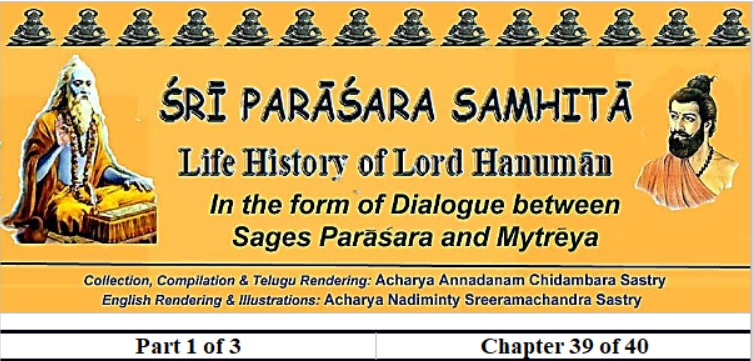
39th Chapter (Ēkōnacatvārinśatpaţalah) – Part 1
“The Story of Establishing the Hanumān Idol”
(Hanuma Dvigraha Pratşţhā Kathanam)
श्रीमैत्रये :
श्लोक:
हनूमद्विग्रहप्राणप्रतिष्ठापनलक्षणं
तत्प्रकारं समाचक्ष्व पराशर महामुने! 1
Mytrēya:
“Oh! Great Sage Parāśara! Tell me about that the features of the Story of establishing the Hanumān Idol, (1)
श्रीपराशर:
रजतेन सुवर्णेन तामे्रण शिलयापि वा
यत्कित्कचिद्रजतस्वर्णमिश्रितेना थ वा मुने! 2
Parāśara:
Making Hanumān Idol
2. “Oh! Mytrēya! The Hanumān idol has to be made of silver or gold or copper or stone or with a mixture of silver and gold. (2)
तामे्रण विग्रहं दिव्यं ध्यानमार्गेण कारयेत्।। 3
A good idol from copper has to be got made while in remaining a stage of meditation. (3)
श्रावणे कार्तिके माघे मार्गशीर्षे थ फाल्गुने
वैशाखै ज्येष्ठमासे च शुभलग्ने शुभे दिने।। 4
In the month of Śrāvaņa (5th) or Kārtīka (8th) or Māgha (11th) or Mārgaśira (9th) or Phālguņa (12th) or Vaiśākha (2nd) or Jyēşţha (3rd), on an auspicious day and in an auspicious ascendant time (lagna), (4)
शांतेन शिल्पकारेण विग्रहं कारयेत्सुधी:
सन्तुष्टमानसं कृत्वा शिल्पकारं गुणोत्तमम्
यंत्कित्कचित्पादमूल्यं च दत्वा विग्रहमादरात्।। 5
The idol has to be got made by a balance-minded sculptor. Such a good charactered sculptor has to be gifted money and made to work on the idol in a pleasant disposition. (5)
श्रावणे कार्तिके माघे मार्गशीर्षे थ फाल्गुने।। 6
The prepared idol of Lord Hanumān has to be brought on an auspicious day in the month of Śrāvaņa (5th) or Kārtīka (8th) or Māgha (11th) or Mārgaśira (9th) or Phālguņa (12th), (6)
ज्येष्ठे वैशाखमासे च पुष्यमासे विशेषत:
गुर्विदुंभृगुवारेषु मन्दवारे विशेषत:।। 7
Or in the month of Jyēşţha (3rd) or Vaiśākha (2nd) or especially in the month of Puşya (10th) month, on a Thursday or Monday or Friday, especially on a Saturday, (7)
आद्र्रादिपव्म्चके चैव रोहिण्यां मृगशीर्षके
उत्तराहस्तचित्रासु पूर्वाभाद्राख्यऋक्षके।। 8
During the five constellations (star) from Ārdra (Betelgeuse), or even in the constellations Rōhiņi (Aldebaran), Mŗgaśira (λ, φ Orionis), Uttara (Denebola), Hasta (α, β, γ, δ and ε Corvi), Chitta (Spica), or Poorvabhādra (α and β Pegasi). (8)
एतेष्वखिलदेवानां प्रतिष्ठा फलदा स्मृता।। 9
It is auspicious and fruitful for establishing (idols) of all gods during the Dhanişţha (α to δ Delphinus) constellation in the month of Śrāvaņa (5th) month or during the Satabisşa (γ Aquarii) constellation in the month of Puşya (10th). (9)
निर्वत्र्य कर्ता पूर्वेद्युर्नित्यकर्म यथाविधि
हनुमद्विग्रहप्राणप्रतिष्ठां सिद्धकर्मणि।। 10
Prāņa Pratişţa
Having performed all the regular rituals (nityakarma) on the previous day, the one imparting ‘life’ to the idol (prāņapratişţha), having (taken) the holy vow (sankalpa) via performing all the decreed rituals (nirņītakarma) for the prāņapratişţha of the Hanumān idol, (10)
करिष्यामीति संकल्प्य कृत्वा पुण्याहवाचनम्
शुचौ देशे महारम्ये मण्डपं चतुरस्त्रमम्।। 11
Pledging so, one must perform the purification (puņyāhavācana), having made a rectangular raised platform (mantapa or mandapa) in a nice and clean place, (11)
कृत्वा संस्थापयेत्तत्र कदलीपादपान्मुखान्
पल्लवै: कोमलै: पुष्पै: नानामणिगणैस्तथा
अलड्कारयुतां तत्र तोरणादींश्च कारयेत्।। 12
The place has to be decorated with fresh banana trunk tops and decked with hanging flowers along with their surrounding tender leaves and of different precious stones. (12)
विचित्ररड्गवल्र्लीं च लेखयेत्सुविराजिताम्
त्रिवारं मण्डपे वास्तोष्पत इत्युच्चरेत्तत:।। 13
Intricate decoratory patterns have to be drawn on the ground with coloured flours (Rangōi art). Then the mantra ‘vāstōşpatē śam catuşpadē’ (= God of the built structures and animals) has to be uttered thrice, (13)
स्थापयेत् स्थलकलशं मण्डपे तण्डुलोपरि
अथाष्टदिक्षु दिक्पालकलशान् स्थापयेत्सुधी:।। 14
Rice grains have to be evenly spread on the mantapa, upon which a bigger vessel (sthūlakalaśa) has to be placed. The wise one places to its right smaller vessels in the eight cordinal directions, places of the rulers of the eight directions, (14)
आदौ ब्रह्मकलशं च कण्ठेषु मुनिसत्तम
तन्तुना पव्म्चधा वृत्त्या कारयेद्बन्धनं तत:।। 15
First a vessel has to be placed in the eastern side, which is the brahmakalaśa (vessel of the Creator). Oh! Great sage Mytrēya! All the vessels have to be tied together by passing a cotton thread six times around their neck regions (just below the mouth). (15)
जम्बूप्लक्षवटाश्वत्थरसालदु्रमपल्लवा:
इत्येते मुनिशार्दूल वक्ष्यन्ते पव्म्च पल्लवा:।। 16
Oh! Mytrēya! Told as the Five Leaves (pańcapallava = the five totems) are the leaves of Jamun (Black plum), Indian fig (Ficus glomerata ), Banyan (Ficus benghalens), Bodhi or Peepal (Ficus religiosa) and Mango shoots. (16)
प्रधानकलशस्यान्त: निक्षिपेत पव्म्च पल्लवान्
नदीजलं समापूर्य फलपुष्पाणि निक्षिपेत्।। 17
The above mentioned pańcapallavas have to be put in the main vessel. Filling it with river water, fruits and flowers are to be placed near it. (17)
पठेच्च ब्रह्मजिज्ञासं ब्रह्मण: कलशस्य च
आराधनं प्रकुर्वीत आचार्यकलशस्य च
आराधनं पूर्ववच्च मूलमन्त्रेण यत्नत:।। 18
Uttering the brahmajigńyāna mantra (attributes of Brahman – satyam = truth), gyanam = knowledge, ananta = eternity) then the brahmakalaśa and the ācāryakalaśa have to be worshipped. As told earlier, with the root mantra, (18)
प्रणवादिचतुथ्र्यन्तैर्नमो न्तैस्स्वस्वनामभि:
इन्द्रादिसर्वदिक्पालकलशानपि पूजयेत्।। 19
Starting with ‘Ōmm’, telling the names of Indra and other rulers of cordinal directions using the 4th case declention (dative = to/for), each name ending with the word ‘namah’, they have to be worshipped. (19)
एतेष्वष्टकलशेषु नमस्तैस्स्वस्वनामभि:
प्रणवादिचतुथ्र्यन्तै: पूजयेच्च यथाक्रमम्।। 20
Following the same orderly mantra-recitation procedure with the eight snaller vessels, the said eight cordinal direction rulers (aşţdikpālaka) have to be worshipped. (20)
जांबवद्विनताद्यैश्च कुर्यादावरणं तत:
जाम्बवान्विनतो नील: पनसो गन्धमादन:।। 21
The premises worship (āvaraņapūja) for Jāmbavan, Vinata and others has to be performed. Jāmbavan, Vinata, Neela, Panasa, Gandhamādhana, (21)
सुषेणमैंदद्विविदान् कलशेषु विनिक्षिपेत्।। 22
Suşēņa, Mainda and Dvivida have also to be worshipped by arranging the rituallistic vessels. Money has to be put in them as per one’s capacity. (22)
गन्धपुष्पैरलंकृत्य वस्त्रालंकरणं तत:
ब्रह्मविष्णुमहादेवदुर्गागणपतींस्तथा
सूर्यादिसर्वदेवांश्च नमस्कृत्य यथाक्रमम्।। 23
Decorating with sandal paste and flowers, then decorating with clothes, then performing obeisance to, in that order, Brahma, Viśņu, Mahēśwara, Durga, Gaņapati, Sun and other gods, (23)
आप्यायस्वेति मन्त्रेण क्षीरमानीयतां तत:
शुक्रमस्येति मन्त्रेण घृतमानीयतां मुने!।। 24
Then to be brought in are milk with the mantra ‘apyāyasva ….’ and ghee with the mantra ‘śukramasi ….’(24)
दधिक्रावुण्ण इति मन्त्रेण दधि आनीयतामथ
मधुवातेति मन्त्रेण मधु आनीयतां मुने।। 25
Then to be brought in are curd with the mantra ‘dadhikrāvuņņō ….’, Oh! Sage Mytrēya! and then honey with the mantra ‘madhuvāţā ….’ (25)
शर्करेति च मन्त्रेण गुडमानीयतां तत:
अयं गौरिति मन्त्रेण गन्धद्वारेति मन्त्रत:
एतन्मन्त्रद्वयं चोक्त्वा गोमयं संग्रहेत्तत:।। 26
Then to be brought in is joggery (dehydrated sugarcane juice) with the mantra ‘śarkarā….’ and cowdung (gōmayam) with the mantra ‘gandhadwārā ….’. (26)
गाय या च गोमूत्रमानीतं मड्गलप्रदं
हिरण्यवर्णमन्त्रेण जलमानीयतां तत:।। 27
Auspicious cow urine (gōmūtra) has to be brought in reciting the name of goddess Gāyatrī. Fresh water has to be brought with the mantra ‘hiraņyavarņām …’. (27)
जलेन पव्म्चगव्येन मेलनं कारयेत्सुधी:
प्रधानकलशे रम्ये सर्वमेतत्प्रपूरयेत्।। 28
The knowledgeble performer has to mix the water with the five cow products (pańcagavya). Whole of this material has to be filled in the beautiful main vessel. (28)
गोमूत्रं गोमयं चैव गोक्षीरं गोघृतं तथा
गोदध्येतानि पव्म्चानि गव्यानीति विचक्ष्यते।। 29
Cow milk, cow curd, cow ghee (clarified butter), cow dung and cow urine) are known as pańcagavya. (29)
गोक्षीरं गोघृतं चैव मधुगोदधिशर्करा:
पव्म्चामृतानि चैतानि कथ्यन्ते मुनिपुड्गव! 30
Cow milk, cow curd, cow ghee, honey and sugar are together known as pańcāmŗuta (five nectars). (30)
कर्मण्यस्मिन् प्रतिष्ठाख्ये त्वमाचार्यो भवेति च
द्विजोत्तमं नियुज्यैकं कर्ता तु स्वयमेव वा।। 31
Since the performer himself is doing the act (establishing the idol), for this prestigious worhip, another Brahmin has to be appointed in-charge, saying ‘tvamācāryō bhava’ (= you be the Guru) is a must, (31)
आपोवेति च मन्त्रेण प्रधानकलशोदकं
करे निक्षिप्य विधिवत् अभिमन् य मुनीश्वर! 32
Oh! Sage Mytrēya! Taking the water from the first vessel in the hollowed palm and sanctifying it with the mantra ‘āpōvā idagm…’, (32)
परिवेष्ट्य नवं वस्त्रं दूर्वा: पुष्पाणि चंदनं
तुलसीं च कुशाग्राणि फलानि विविधानि च।। 33
Covering around the vessel with a new cloth, common garika or green grass (creeping panic grass), flowers, sandal paste, holy basil, tips of the darbha grass (Desmotachya bipinnata), different fruits, (33)
यथाशक्ति हिरण्यं च घटमध्ये विनिक्षिपेत्
बन्धनं कारयेद्धीमान् औदुम्बरसमित्त्रयम्।। 34
And money as per capacity has to be kept in the vessel. Three cluster fig (Ficus glomerata) twigs have to be tied together. (34)
दर्भरज्ज्वा त्रिरावृत्य पृष्ठभागे हनूमत:
स्थापयेत्पीठमध्ये च हनूमद्विग्रहं तत:।। 35
Seating (locating) the Idol
They (the vessels) have to be tied together with a rope made of darbha grass, keeping it held ro rhe back portion of the Hanumān idol, the Hanumān idol has to be placed in the middle of the raised platform (mantaaa or mandapa). (35)
कस्तूरीचन्दनाद्यैश्च तिलकं धारयेत्सुधी:
परिवेष्ट्य नवं वस्त्रं मूलमन्त्रेण यत्नत:।। 36
Reciting the root mantra, the Lord’s idol has to be wrapped in new clothes, the ardent performer (karta = doer) has to apply vertical red mark of musk (kastūri) (in the middle of the forehead).and sandlewood paste (candana) to the Lord (36)
स्नानं पंचामृतैर्दिव्यै: कारयेन्मूलमन्त्रत:
अब्लिड्गमन्त्रै: कुर्वीत स्नानं शुद्धोदकैस्तथा 37
Reciting the root mantra, the idol has to be bathed with pańcāmŗta, followed by pure water bath (śuddhōdakasnāna) reciting the Vedic purifying (ablinga) mantras. (37)
पव्म्चोपचारान्देवाय यथाविधि समर्पयेत्
गन्धं पुष्पं च धूपं च दीपं नैवेद्यमेव च
उपचाराश्च पंचैते मुनिभि: परिकीर्तिता:।। 38
As decreed, one has to submit to the Lord the five service offerings (pańcōpacāras), i.e., application of sandlewood paste (gandha), offering flowers (puşpa), offering fragrant incence (dhoopa), light (deepa) and pure food (naivēdya). (38)
सुगव्म्चमेति मंत्रेण तथा वारुणसूक्तकै:
अब्लिड्गमंत्रैश्चान्यैश्च तथा वै दश शांतिभि:।। 39
Reciting the mantra ‘sugancama ….’ The Lord’d idol has to be placed in the vessel, Reciting the upavişanmantra, vāruņasūkta, ablingamantras, other mantras, with the ten pacifications (daśaśāntibhih), (39)
पव्म्चामृतैश्शुद्धतोयै: स्नापयेद्धनुमत्प्रभुम्
पव्म्चोपचारान्देवाय दिक्पालेभ्यस्समर्पयेत्।। 40
The Hanumān idol has to be bathed in the pańcāmŗt (five nectars) and then with pure water. The the pańcōpacāra (five offerings) have to be submitted to Hanumān and the rulers of the cardinal directions. (40)
हनुमíक्षिणभागे नीलं चैव प्रपूजयेत्
जलाधिवास: कर्तव्यो याममात्रं च स्वामिन:।। 41
The idol of Neel, kept on the right sade of Hanumān, too has to be worshipped (similarly). The Lord has to be kept in water for one yāma (three hours) time. (41)
कारयेद्वाद्यघोषं च महोत्सवकरं यथा
एवं जलाधिवासाख्यप्रकार: कथ्यते बुधै:।। 42
The whole procedure has to be carried out like a great festival with the background sounds of musical instruments (vādyaghōşa). (42)
उत्तिष्ठ ब्राह्मण इति जलस्थं देवमुद्धरेत्
कदलीवनमध्ये तु रड्गवल्लीं प्रकल्पयेत्।। 43
A rangavalli or rangōli design has to be drawn in the middle of a banana garden.The Lord’s idol has to be lifted from water, reciting the mantra ‘uttişţha brahmaņaspatē …’. (43)
तत्र पीठे महारम्ये याममात्रमनन्तरम्
सुगव्म्चमेति चोच्चार्य स्थापयेदव्म्जनासुतम्।। 44
After a yāma (3 hours) time, reciting the mantra ‘sugamcamē’ the Lords’ idol has to be placed on beautiful seat at the place (of rangavalli). (44)
हनुमत्तापनीयेन देवं पव्म्चामृतैश्शुभै:
स्नानं शुद्धोदकैर्दिव्यै: कारयेच्च यथाविधि।। 45
Reciting Hanumān relaxing (tapaneeya) Upanishat mantras, the idol has to be bathed clean as stipulated, first with pańcāmŗta and then with pure water. (45)
कृत्वा पव्म्चोपचारांश्च गीतवाद्यानि कारयेत्
एवं च कदलीवासप्रकार: कथ्यते बुधै:।। 46
After performing the pańcōpacāra (five services), vocal and instrumental music has to be played. Thus described is the method of establishing Lord Hanumān in a banana garden (kadaleebana). (46)
उत्तिष्ठ ब्राह्मण इति कदलीवनमध्यत:
पुनर्देवं समुद्धृत्य याममात्रं तत:परम्।। 47
Praņapratişţha (Imprting Life)
Having taken out the idol from the middle of the banana grove, reciting the mantra ‘uttişţha brahmaņa …’, (47)
कदलीचूतखर्जूरनारिेकेलफलादिषु
सुगव्म्चमेति मन्त्रेण स्थापयेद्धनुमत्प्रभुम्।। 48
Establishment of Lord Hanumān’s idol has to oerformed, reciting the mantra, ‘sugamcama …’, for a yāma time, amidst fruits of banana, mango, dates and coconut. (48)
हनुमद्वेदशिरसा पुन: पव्म्चामृतैश्शुभै:
हनुमद्विग्रहं पूज्यमभिषिच्य महोत्सवै: 49
Reciting Hanumān relaxing (tapaneeya) and Upanishat mantras, in a great festival ambience, the idol has to be bathed in clean water as stipulated, (49)
पव्म्चोपचारान्देवाय यथाविधि समर्पयेत्
एवं फलादिवासस्य प्रकार: कथ्यते बुधै:।। 50
The pańcōpacārās have to be performed. With the phalādhivāsa (amidst-fruits stay) ritual of imparting ‘life’ of the Lord, converts a mere stone idol into a deity worthy of woraship, as per āgamaśāstra (idol worhship scriptures) as per procedure told by the scholars. (50)
उत्तिष्ठ ब्राह्मण इति स्वामिनं फलवासत:
उद्धृत्य च पुनर्देवं तत: पव्म्चामृतेषु च
सुगव्म्चमेति चोच्चार्य याममात्रं विनिक्षिपेत्।। 51
Lifting from the phalādhivāsa (amidst-fruits stay) with the ‘uttişţhabrahmaņa …’ the Lord has to be placed for a yāma with the ‘sugamcamē …’ mantra. (51)
पव्म्चामृतैश्शुद्धतोयैर्नमकेना भिषेचयेत्
पव्म्चोपचारान्कुर्वीत नृत्यगीतमहोत्सवै:।। 52
Reciting the namakam (namō = salution) mantra (one of the two main invocation mantras for Śiva along with camakam, which says camē = give me), the Lord has to be holy-bathed (abhişēka) with pańcāmŗta followed by pure water. The five services (pańcōpacāra) have to be performed with singing and music in a festival spirit. (52)
पव्म्चामृताधिवासाच्च हनुमत्प्रभुमुद्धरेत्
उद्धृत्य धान्यराशौ च विध्युक्तं स्थापयेत्सुधी:।। 53
Taking the Lord Hanumān diety from the pańcāmŗta, the knowledge-full performer has to place the same in a heap of paddy. (53)
व्रीहयश्चम इत्येव मन्त्रमुच्चार्य यत्नत:
नाना धान्यानि संगृह्मा एकरंशिव्म्च कारयेत्।। 54
Reciting the mantra ‘vreehayaśca …’ with great efforts, different varieties of grains and millets have to be collected and made into a heap. (54)
सुगव्म्चमेति चोच्चार्य विग्रहं तत्र निक्षिपेत्
पव्म्चामृतैश्शुद्धतोयैरभिषेकं च कारयेत्।। 55
Reciting the mantra ‘sugamcamē …’ the Lord’s Deity has to be placed in it for a yāma and then a holy bath be performed with pańcāmŗta, followed with pure water. (55)
तत: पव्म्चोपचारांश्च कपीशाय समर्पयेत्।। 56
Then the Five Services (pańcōpacāra) have to be submitted to the Lord hero of monkeys, Hanumān. (56)
अधश्शयनमाचार्यो ब्रह्मचर्यं तत: परम्
जितेन्द्रिय: फलाहार: कुर्यात्सूर्योदयावधि।। 57
The preceptor should sleep on the floor, follow celibacy and control his senses and survive on fruits alone from sunset till the sunrise. (57)
नृत्यगीतादिवाद्यैश्च पुराणपठनेन च
वेदपारायणेनैव कुर्याज्जागरणं तत:।। 58
One hs to keep self awake (jāgaraņa) in the night via engaging in singing, dancing, playing mucal instruments or reading religious texts or recitation of Vedas. (58)
एवं धान्याधिवासस्य प्रकार: कथ्यते बुधै:।
एवं पव्म्चाधिवासेषु क्रमेण मुनिपुंगव!
सुवर्णपुष्पताम्बूलं श्रद्धायुक्तस्समर्पयेत्।। 59
Thus told was the procedure of stay amidst the paddy heap. Oh! Mytrēya! Thus during the five-stays (amidst flowers, fruits, pańcāmŗta, pure water and heap of paddy) mentioned, very devotedly, one has to submit gold/coins/flower weighted (suvarņapuşpa) respectful bows and betel leaves (tāmboolam). (59)
प्रातरुत्थाय शुद्धात्मा हनुमुद्रिक्तिसंयुत:
स्नानसंध्यादिकं कर्म निर्वत्र्य नियतेन्द्रिय:।। 60
That holy-souled (suddhātma) performer, on waking up in the morning, with great devotion and control over senses, after performing bath, regular prayers and other routine rituals (nityakarna), (60)
उत्तिष्ठ ब्राह्मण इति हनुमद्विग्रहं तत:
धान्याधिवासादुद्धृत्य पीठमध्ये विनिक्षिपेत्।। 61
Reciting the mantra ‘uttşţha brāhmaņa …’, the Hanumān deity has to be lifted from the stay within the paddy heap and established in the middle of the raised seat (peeţham). (61)
पव्म्चामृतैश्च शुद्धतोयै: कुशोदकफलोदकै:
पुष्पोदकै: पव्म्चगव्यै: पुरुषसूक्तेन वै तत:।। 62
Following the puruşasookta-oriented method (from Ŗgvēda, 10.8.90), after the pańcāmŗta, pure water, sprinkling (samprōkşaņa), of water over fruits, over flowers and over panńgavya (five cow products) is done usding darbha grass, (62)
विधिना स्नापयेद्देवं पट्टवस्त्रं समर्पयेत्
पव्म्चोपचारान्देवाय तांबूलं च समर्पयेत्।। 63
Having performed well the holy bath to the Lord, adorning with silks, performing the Five Services (panńcōpacāra), offer of betal leaves (tāmboolam) and other things are to be submitted to the Lord. (63)
इति श्रीपराशरसंहितायां श्रीपराशरमैत्रेयसंवादे श्रीहनुमद्विग्रहप्रतिष्ठाकथननाम एकोनचत्वारिंशत्पटल:
Thus ends 39th Chapter (Ēkōnacatvārinśatpaţalah) “The Story of Establishing the Hanumān Idol” (Hanumadvigraha pratşţhā kathanam)
of Śrī Parāśara Samhitā
![]()

Click here to visit the Contents of the Part 1.
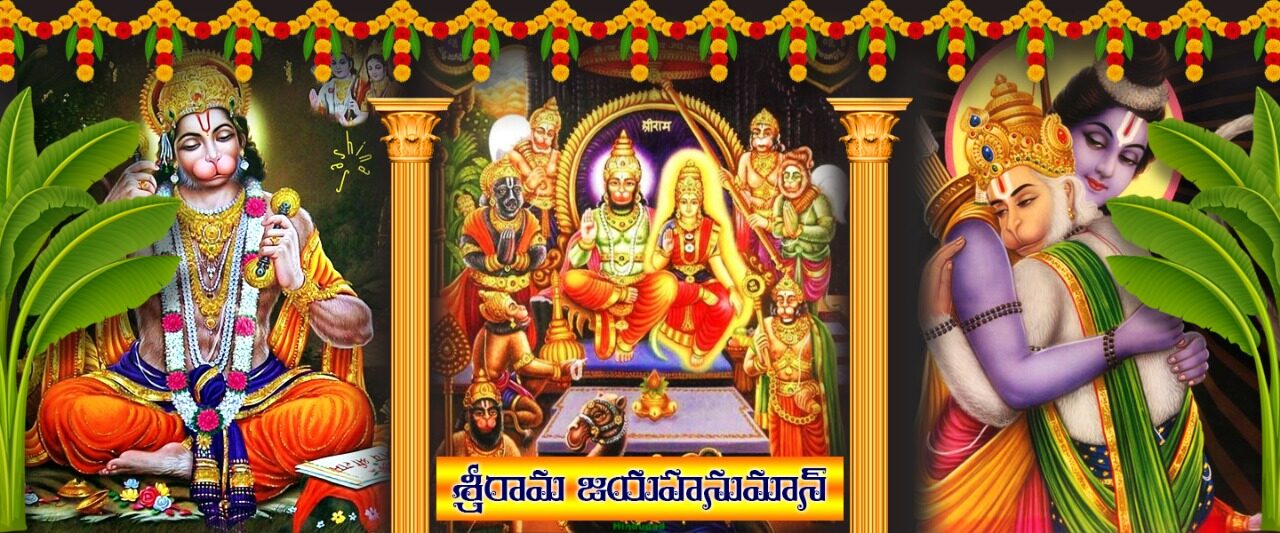



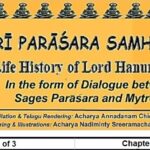
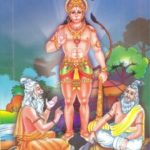
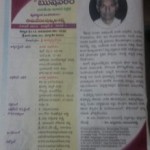
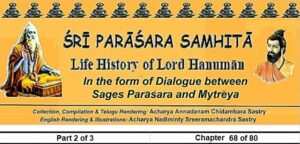
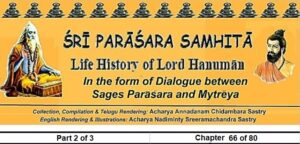
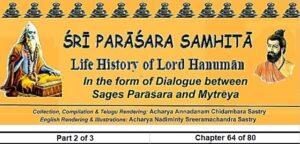
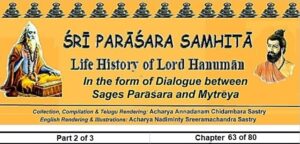
Be First to Comment